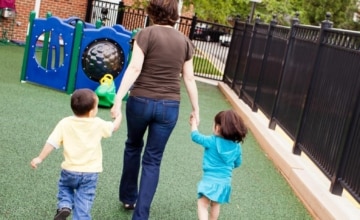Jennifer L. Harman, Victoria W. Willard, and Niki Jurbergs, St. Jude Children’s Research Hospital, Memphis, Tennessee

Abstract
Infants and toddlers account for a disproportionate percentage of children diagnosed with cancer. These young children and their families benefit when infant and early childhood mental health is recognized as vital and integrated with medical treatment. Such interventions are beneficial for supporting families in coping when cancer is the only stressor, and they become even more essential when cancer is just one in a series of stressors impacting a family, as is often the case. The authors discuss three abridged stories of collaborative, interdisciplinary, family-centered services provided for young children with cancer and their families, elucidating the importance of supporting the whole family and the young child alike in the context of pediatric cancer treatment.
Approximately half of all new cases of pediatric cancer occur during the early childhood years, with the highest incidence in babies less than 12 months old (U.S. Cancer Statistics Working Group, 2017). In the context of lengthy treatment plans and multiple hospitalizations, these young children miss exposure to and experiences with many developmentally normative activities (Harman, Wise, & Willard, 2018). Yet, when professionals across disciplines come together to provide integrated, family-centered support services, the overall development and well-being of very young children undergoing cancer treatment is enhanced. There are no doubt many examples of the positive impact of this approach. The stories of Mia, Jesse, and Anthony, whose names were changed to maintain anonymity, are shared here to illustrate three unique cases in which infant and early childhood mental health (IECMH) principles were infused within the context of pediatric cancer treatment. Each child’s circumstance was very different and thus the approach to treatment they required varied quite significantly. However, together, their stories illustrate the range of concerns with which IECMH principles can assist, the importance of relationships when working on behalf of young children, and how an interdisciplinary team can support children and their families.
Mia: Making Every Moment Count
Mia was a beautiful, vocal 11-month-old baby when she was diagnosed with an incurable brain tumor. Her parents noticed a regression in her developmental skills coupled with inexplicable bouts of vomiting; these symptoms are what eventually led to her devastating diagnosis. The psychology department was consulted almost immediately upon Mia’s arrival to the hospital, with the reason for referral simply “adjustment to diagnosis.” When initially gathering the family’s history, both parents described their understanding of Mia’s diagnosis and prognosis. They were hoping for a miracle yet understood the grim reality they faced. Mia’s mother commented that she needed to be the voice for her baby; however, she was afraid that she would not be able to tell when Mia was in pain or feeling nauseous. She also worried about upsetting medical providers; she was terrified of being perceived as ungrateful if she asked a question—any question. Both of Mia’s parents wondered through tears whether they would ever see Mia crawl or stand again; her father said over and over, “I might never see her walk.”
Mia’s parents proudly showed videos of their daughter prior to her diagnosis. Her laugh was infectious. Many of the videos included interactions between Mia and one or both of her parents. It was clear that both parents were warm, responsive, loving caregivers—however, her mother’s responsivity seemed somewhat thwarted in those initial weeks post diagnosis when I first met them.1 Yet, Mia’s mother, who had a history of depression, seemed to grasp the importance of considering, or reflecting upon, Mia’s mental states and the impact these mental states had on Mia’s behavior and general presentation (a skill known as reflective functioning); and, she, unwittingly demonstrated great insight into barriers to her responsivity. She repeatedly stated that one of her greatest fears was that she would miss cues or misread cues—particularly given the incredible sadness she was feeling.
1 Throughout this article, “I” refers to Jennifer L. Harman.
Mia and her parents met regularly with me, a psychologist at the children’s hospital where Mia received cancer-directed treatment. The primary goal of our work was to support and improve Mia’s overall well-being. An important component was to enhance Mia’s parents’ reflective functioning—skills they both clearly possessed prior to Mia’s diagnosis. In fact, the videos that Mia’s parents showed me in our initial consult were used in later sessions as reminders of their competence and previous practice of reflective functioning and appropriate responsivity. Reflective functioning also was discussed and modeled for parents in sessions; and they were directly coached through use of these skills. Not surprisingly, as parental reflective functioning increased so did Mia’s mother’s responsivity. Mia’s mom commented that wondering about Mia’s internal state helped her know what to say when “being Mia’s voice.” She also noted that she believed that her use of reflective functioning helped her identify when Mia was in pain or nauseous and appropriately respond in ways that soothed her. Mia’s father noted it helped him feel even more connected to his baby, and both parents commented that it helped them feel grounded.
Mia also was treated by a physical therapist, a speech–language therapist, and an occupational therapist throughout this time, and together we created an integrated, family-centered treatment plan to guide their work with Mia and her family. Sometimes I joined these therapists to co-treat, as Mia’s engagement in rehabilitation services provided ample opportunities for her parents to work on their own skills. Her parents reported enjoying these co-treatment sessions, with her father once commenting that it was clear to him that everyone was working toward the same goal and doing so with the entire family in mind. This was gratifying to hear, as the goal of the individual support disciplines was not to simply communicate with one another but to provide integrated, family-centered, interdisciplinary support.
Mia passed away just before turning 18 months old. Since then, I have received a card each year from her parents. Invariably, the prose written within highlights the joy this family experienced in watching their daughter regain lost developmental milestones prior to her death, how thankful they are that they were so well supported by the interdisciplinary team in their journey, and how they believe that their work with me helped them be as present with their baby as possible throughout 7 very difficult months. They always comment that they are grateful they were able to make the most of every moment of Mia’s life—something made possible due to the infusion of IECMH principles within her care.

Mia’s mother seemed to grasp the importance of considering, or reflecting upon, Mia’s mental states and the impact these mental states had on Mia’s behavior and general presentation (a skill known as reflective functioning). Photo: fizkes/shutterstock
Jesse: Crisis as a Catalyst for Change
Jesse’s story is quite different from Mia’s in many ways; however, the impact of the incorporation of IECMH-informed practices is just as great. When I initially met Jesse, he was 26 months old and recently diagnosed with a type of eye cancer that has a relatively favorable prognosis. He was referred to our institution’s interdisciplinary early childhood clinic by his primary oncologist after noting developmental concerns during her initial assessment. Specifically, Jesse could not sit independently or roll over, demonstrated occasional difficulty with head control, and made no vocalizations other than cries. Yet, his developmental presentation was not what struck me most during my first encounter with Jesse and his mom; and, frankly, it was neither his cancer nor his development that initially worried me most.
For the first several weeks I worked with them, Jesse’s mom spoke in a hushed, meek tone of voice. She frequently averted eye contact, and she rarely engaged with Jesse or responded to his cries. She presented as guarded and afraid—but in a way that was qualitatively different from the relatively normative fear often observed in parents of young children newly diagnosed with cancer. At one point, members of Jesse’s team considered the appropriateness of a referral to the Department of Children and Family Services for neglect; but Jesse’s mom was providing the necessary medical care, and she was bringing him to all appointments. Therefore, no referral was made.
After I spent a few sessions with Jesse and his mom, I wondered whether his mom’s presentation was a combination of the typical, expected cancer-related fear along with something else, perhaps something premorbid or otherwise entirely unrelated to Jesse’s diagnosis. I also pondered how her aloofness impacted his current functioning and how much of a barrier it might be to developmental progress. Unfortunately, learning more about Jesse, his mom, and their history proved quite difficult. Jesse’s mom answered direct questions with as few words as imaginable. In fact, she often managed to respond to open-ended prompts with only a gesture or single word. Multiple early childhood team members from various disciplines (psychology, speech–language therapy, occupational therapy, physical therapy, audiology, social work, and child life) observed a similar presentation during their sessions with this family. In fact, Jesse’s speech–language therapist noted during one treatment planning meeting that although mom was physically present during sessions, she seemed completely absent. That was certainly an accurate portrayal, as nobody seemed able to join with her, or have her join with them, in their treatment of Jesse. All felt that this lack of connection with his mother was also inhibiting the team’s ability to connect with and make progress with Jesse.
These issues persisted until the day Jesse and his mom arrived to a joint psychology and social work appointment with Jesse’s mom dressed for a blustery winter day even though it was the middle of the summer. Ironically, one topic slated for discussion during that joint session was an honest conversation about the difficulty getting traction in our work on behalf of Jesse. That conversation never took place; new circumstances made it unnecessary.
Immediately upon entering the privacy of the office, Jesse’s mom burst into tears stating that she needed help. She recently met a man with whom she quickly entered a serious relationship. He became physically violent with her and attempted to choke her; her winter attire was to hide multiple bruises. The social worker and I sat with Jesse’s mom for what felt like an eternity. It was a much longer session than either of us had intended, but this mom was in need, and she was opening up. This crisis was the catalyst for change. Our nonjudgmental presence with her during that time instantly built our rapport with her. I did not do much that day other than remain present and supportive with mom and assist with Jesse; the social worker took a much more active role. Together, we provided mom with information on local resources and the social worker further assisted her with securing these services, including individual therapy, and banning this man from the hospital grounds.
Subsequent to that summer day, Jesse’s mom slowly became more and more engaged in all of Jesse’s therapies—physical, occupational, and speech–language therapy, dyadic psychotherapy, and developmental play-based interventions. She slowly, but surely, became more and more open with all care providers across the hospital; and the team’s concerns about potential neglect faded away. Unsurprisingly, as Jesse’s mom became more engaged, Jesse began to make developmental gains. Indeed, I had the privilege of seeing an incredible transformation in the parent–child relationship, and, in turn, with regard to Jesse’s overall functioning. In one profound session several months in, Jesse’s mom vocalized that, to date, her way of being a mother to Jesse, and how she approached their relationship, was incongruent with how she wanted to be as a mom and with the mom she believed her son deserved. From then on she put in significant work related to her relationship with her son and to how she cared for and parented him—and this is when we saw the most significant gains for Jesse across the board. Yet, not everything consistently went smoothly once mom had that epiphany. Although she slowly mastered the art of parental reflective functioning, consistent implementation remained a struggle, and the “ghosts” from her past did not simply vanish into thin air. Luckily, there was an incredible interdisciplinary team standing with and supporting Jesse’s mom as she sought to make changes.
My job was not to directly “treat” any of Jesse’s mom’s individual issues—that was the job of her personal therapist. Rather, my work with Jesse and his mom focused on how factors from her past impacted her way of being with Jesse, and thus impacted her relationship with him and his overall developmental progress. In exploring and addressing this, Jesse’s mom often discussed feeling angry that he had cancer and that he was so far behind developmentally. She described her relationship with Jesse’s father, which was characterized by multiple beatings, including during her pregnancy. She questioned whether this was why Jesse had gotten cancer—fortunately she was able to hear professionals when reassured that nothing she did caused her son’s cancer. Jesse’s mom also wondered at times whether Jesse would be less delayed had she been under less stress and not beaten during her pregnancy. Honestly, I wondered the same, yet never aloud—and I felt sadness and anger related to their situation. She discussed her cultural belief that “the sins of the parent are bestowed upon the child”—and noted that seeing the adversities Jesse faced made her feel immensely guilty for her “sins of the past.” Although she worked through these ghosts in her own individual therapy, to pretend they have no bearing on Jesse’s functioning and thus were never incorporated into dyadic therapy would be a farce. Yet, the dyadic work we did together always focused on the impact on Jesse and his relationship with his mom. The child was always held in mind and central to our work.
The work Jesse’s mom did in her own therapy primed her for being able to reflect on how her perceptions, beliefs, and expectations directly impacted Jesse. And, her way of being began to shift. She said that prior to individual therapy the only way she was able to manage her strong, negative feelings was to try to feel nothing at all; and this is why she was so distant with Jesse. Over our almost 2 years working together, I saw this change. She was no longer distant with him. Instead, she appropriately responded to his bids for attention, and she was seen actively implementing recommendations from Jesse’s rehabilitation therapists. She smiled when she looked at her son and hugged him on occasion. Even the way in which she spoke his name and talked about him seemed to shift in a positive direction. Jesse was comforted by his mom’s presence, something that was largely absent when we first met them.
Jesse is now cancer-free and back in his home community. He is attending school with intensive support services in place, and his mom continues to attend therapy sessions with him outside of school. Most important, he is learning and developing. Although it is happening at a rate slower than that of most children, he is continually making progress and moving in the right direction. The family returns periodically for medical follow up. Each time they do, all members of the early childhood team speak with amazement at how far this child, his mother, and their relationship have come.
Anthony: Finding His Smile
Unlike Jesse and Mia, I did not meet Anthony until more than a year into his treatment. He was 32 months old at the time and had spent most of his life in medical settings battling recurrent, refractory leukemia. He had adjusted and coped well with treatment until the weeks leading up to his psychology consult, at which time he had become irritable and easily agitated.
Anthony’s medical team consulted the psychology department, at the urging of his physical therapist. Anthony was refusing to engage in therapy sessions with her, and she was seeking help with the creation of a behavioral plan for him. By this point, Anthony had been inpatient for 7 weeks. Reportedly the first 3 weeks of this inpatient stay went well, and he was his typical jovial, sweet, and engaging self during that time.

The goal of the individual support disciplines was not to simply communicate with one another but to provide integrated, family-centered, interdisciplinary support. Photo: Zurijeta/shutterstock
Prior to meeting the family, I asked his primary nurse practitioner to tell me about Anthony and any concerns she had. Consistent with his physical therapist’s report, she noted that his behavior changed 3 weeks into his current hospitalization, adding this was probably due to the steroids he was prescribed the first week inpatient. I found this odd as the behavioral changes associated with steroid use most often dissipate when steroids are discontinued.
Upon meeting Anthony, I immediately noticed how tired his father and grandmother looked. As soon as I walked in the room he screamed. Once he stopped screaming, he requested juice. When his grandmother gave him the juice, he threw it. Anthony’s grandmother calmly and matter-of-factly stated “You threw the juice cup, so no juice” and went about doing something else. Given that my presence appeared to aggravate Anthony, I asked his father if he would like me to return later. He commented that Anthony was “always like this now” so there would not be a better time, but that we could speak in the adjoining parent room.
Anthony’s father appropriately informed Anthony of where he was going and told him that he would be able to see us through the window. Anthony calmly nodded “yes,” and then asked his dad to hand him a particular stuffed animal. As Anthony’s father handed him the toy, Anthony screamed in anger and threw it at his dad. With tears in his eye, his dad looked at me and said, “This is not my boy.”
Anthony was born full-term and there were no complications. He was slow to walk but reportedly began to talk early and was already a whiz at preschool puzzles. Anthony’s mother had been hospitalized and diagnosed with a severe mental illness about a month prior to Anthony’s initial leukemia diagnosis. Anthony’s parents were not married, and the strain of events that led to Anthony’s mother’s psychiatric hospitalization resulted in their separation. Anthony’s father had full custody, and Anthony had not seen his mother in approximately 2 years. Anthony’s paternal family history was also significant for depression and anxiety; and Anthony’s dad was prescribed antidepressants and engaged in monthly therapy sessions.
Prior to his current hospitalization, Anthony was described as generally compliant, or as compliant as a typical toddler. He had occasional tantrums when he did not get his way—but, these tantrums never lasted more than a moment and happened only once or twice a month. His dad said that Anthony was previously easily distracted by other things when on the cusp of a tantrum. He also said that Anthony formerly responded well when provided validating statements like “I can see you are mad; it’s hard to be told no.” Yet, currently, comments such as this seemed to fuel Anthony’s anger and irritability. Anthony’s dad said that previously when distraction or validating statements were unsuccessful, he would ignore the tantrum and it would stop in less than a minute or two. By the time we met, Anthony’s tantrums seemed to go on indefinitely.
Anthony’s father was quite composed when describing Anthony’s medical history and the events that brought them to our hospital; however, when he began to describe the recent changes in his son’s behavior, he became tearful. It was clear he felt desperate and thought that this was negatively impacting his relationship with his son. He described approximately a month of this increased irritability. He also noted that Anthony frequently called himself “bad” and “dumb” and bit himself in fits of anger. He also bit others, but not as frequently as he bit himself. He no longer had much interest in playing with his favorite toys, and, on the rare occasions when Anthony was engaged in play, it was very aggressive and included characters intentionally hurting and killing others. Anthony also seemed to have much less energy, with his dad half-joking that Anthony saved all of his energy for screaming fits.
Anthony also refused to engage in or allow self-care activities to occur. It was a battle to get Anthony to change clothes each day or to allow someone to bathe him; and he refused to participate in developmental interventions or physical or occupational therapy. He would take his medication but screamed at the nurses while doing so. He also screamed when the nurses took his vitals or simply asked if he or the family needed anything. Anthony reportedly was also not eating much, which could have been due to the medication he was taking, and he slept only a few hours each day. His dad said that Anthony had trouble falling asleep and staying asleep—often remaining awake for most of the night. Given his extended hospital stay, I consulted psychiatry to help rule out delirium, as a few of Anthony’s symptoms were associated with delirium in young children during extended hospital stays.
Once delirium was ruled out, I considered Depressive Disorder of Early Childhood—Anthony certainly met classification criteria according to the DC:0–5TM: Diagnostic Classification of Mental Health and Developmental Disorders of Infancy and Early Childhood (DC:0–5; ZERO TO THREE, 2016). However, I did not rush to assign a diagnosis, allowing time to continue gathering information—across settings, across informants, and across modalities. I assessed Anthony and his father’s relationship adaptation and classified it as Level 2–Strained to Concerning. Although many adaptive qualities remained present, Anthony’s current presentation was wearing on his relationship with his dad. Anthony’s father, himself, reported that he was less patient with Anthony and enjoyed him less and less. Similarly, the adaptive functioning of the caregiver environment was a Level 2–Strained to Concerning. Anthony’s dad reported that Anthony’s grandmother helped with much of Anthony’s care and she should be considered one of his primary caregivers; but he reported that they often disagreed on parenting styles and decisions for Anthony. He noted that he was embarrassed to say they often had heated debates in front of Anthony and would occasionally yell at each other in his presence.

It is appropriate to support the overall well-being of young children and families, particularly when faced with exceptionally scary, unthinkable, or uncertain circumstances. Photo: Komsan Loonprom/shutterstock
After seeing Anthony’s behavior across time in both structured and unstructured settings, obtaining additional information from Anthony’s grandmother and medical team providers, considering the relational context (DC:0–5 Axis II), gathering information related to the potential impact of psychosocial and environmental stressors (DC:0–5 Axis IV), gathering information on Anthony’s developmental competence (DC:0–5 Axis V), and considering all of the information gathered within the context of his complex medical history (DC:0–5 Axis III) it became clear that Anthony’s presentation was, indeed, best classified as Depressive Disorder of Early Childhood (DC:0–5 Axis I). I provided my case conceptualization to Anthony’s family and medical team, along with educational information about what depression looks like in very young children and how we treat it.
I then met with the occupational therapist, physical therapist, and child life specialist to discuss how we could come together to support Anthony and his family, facilitate Anthony’s participation in necessary therapies, and reinforce each other’s work in our individual sessions. We came up with a tentative plan and discussed it with the family; modifications were made based on family input; and the plan was put into place. After several weeks, Anthony began to engage in developmental interventions, physical therapy, and occupational therapy. He, his father, and his grandmother regularly attended therapy sessions with me, and I saw great progress—both in Anthony’s individual presentation and with regard to the relational context.
Unfortunately, Anthony’s disease continued to progress, resulting in his eventual death. Like Mia’s parents, Anthony’s father and grandmother indirectly commented on their gratitude for IECMH-informed services. Specifically, when they returned for the hospital’s annual “Day of Remembrance” his grandmother hugged me and thanked me for helping Anthony “find his smile again” before his death. His father agreed, adding profuse thanks for the integrated support services provided by the early childhood team.
Closing Reflections
Although the stories of these three families are quite diverse, each highlights the importance of IECMH in the pediatric oncology setting; and each elucidates the importance of relationship-based work on behalf of these children. Sometimes cancer itself and adjustment to the diagnosis is the presenting issue (Mia), but sometimes cancer is simply an added layer of complexity (Jesse). Often times, making a DC:0–5 Axis I classification is not necessary (Mia), but sometimes it is (Anthony); and while many young children diagnosed with cancer survive, some, like Mia and Anthony, do not. It is appropriate to support the overall well-being of young children and families, particularly when faced with exceptionally scary, unthinkable, or uncertain circumstances. This is something done best when various disciplines work collaboratively, adopt a family-centered approach, foster relationships with parents, and leverage those relationships to work on behalf of young children. Partnering with parents is key, as they are a vital part of the interdisciplinary team. Indeed, we are stronger together.
Learn More
DC:0–5TM: Diagnostic Classification of Mental Health and Developmental Disorders of Infancy and Early Childhood
ZERO TO THREE (2016)
DC:0–5 is a comprehensive, multiaxial, developmentally based, and relationally informed classification system used for the diagnosis of developmental and mental health disorders in children under 5 years old. Given its careful consideration of context, it also is quite useful in the identification of targets for prevention and intervention efforts. For additional information related to the DC:0–5, or for information on becoming trained in use of the DC:0–5, please visit https://www.zerotothree.org/our-work/learn-professional-development/dc0-5-manual-and-training/
Together
Together.stjude.org is a comprehensive online resource about pediatriccancer. It includes medical information, including information about the diagnosis itself, treatments, and physical and psychological effects. Resources are available for patients and families, with information provided in an easily absorbed format. While Together is created and maintained by St. Jude Children’s Research Hospital, information and resources are appropriate for anyone, regardless of institution.
Pediatric Psychosocial Oncology: Textbook for Multidisciplinary Care
A. N. Abrams, A. C. Muriel, & L. Wiener (Eds.; Springer, 2016) This textbook provides an overview of the psychosocial issues faced by children and adolescents with cancer. It provides clinicians with a deeper understanding of the complexities and challenges of working with this population. Chapters address issues such as education, procedural support, coping and adjustment, social media use, spiritual care, and neurocognitive concerns after treatment.
Author Bios
Jennifer L. Harman, PhD, is a pediatric psychologist, assistant faculty member, and assistant director of the Psychology Clinic at St. Jude Children’s Research Hospital. She received her doctorate from the University of Florida and specializes in work with very young children and their families.
Victoria W. Willard, PhD, is a pediatric psychologist and assistant faculty member in the Department of Psychology at St. Jude Children’s Research Hospital. She received her doctorate from Duke University, and her research program focuses on social– emotional development in children with cancer.
Niki Jurbergs, PhD, is a pediatric psychologist, associate faculty member, and director of the Psychology Clinic at St. Jude Children’s Research Hospital. She received her doctorate from Louisiana State University and specializes in behavioral interventions and interventions to address psychological adaptation to illness and disease.
Suggested Citation
Harman, J. L., Willard, V. W., & Jurbergs, N. (2020). Relationships and interdisciplinary collaboration: Integrating infant and early childhood mental health in the pediatric oncology setting.
References
Harman, J. L., Wise, J., & Willard, V. W. (2018). Early intervention for infants and toddlers: Applications for pediatric oncology. Pediatric Blood and Cancer, 65(5), e26921. doi: 10.1002/pbc.26921
U. S. Cancer Statistics Working Group. (2017). United States cancer statistics: 1999–2014 incidence and mortality web-based report. Atlanta, GA: U. S. Department of Health and Human Services, Centers for Disease Control and Prevention and National Cancer Institute. Retrieved from source
ZERO TO THREE. (2016). DC:0–5TM: Diagnostic classification of mental health and developmental disorders of infancy and early childhood. Washington, DC: Author.




